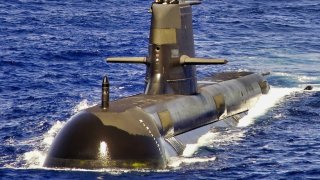Australia Has Only 1 Collins-Class Submarine 'In Service'
Australia’s Collins-class submarines face significant setbacks due to widespread hull corrosion, with only one currently operational as the remaining five await urgent repairs or upgrades.
What You Need to Know: Australia’s Collins-class submarines face significant setbacks due to widespread hull corrosion, with only one currently operational as the remaining five await urgent repairs or upgrades.

-Maintenance delays, partly from labor strikes, compound the challenges for Australia’s diesel-electric subs, underscoring the urgent need for new capabilities through the AUKUS pact’s nuclear-powered submarines planned for the mid-2030s.
-Despite current woes, the Collins class was once a technological leap, with advanced stealth, automation, and endurance, adapted for Australia’s vast and varied waters. The subs remain essential for intelligence and defense, with future operations extending potentially to Eastern Australia.
How Few Remain – Australia Has Just One Collins-Class Sub in Service
Australia is a key partner in the AUKUS program with the United Kingdom and the United States, and its first pillar calls for the building of a new class of nuclear-powered submarines that could be operated by the Royal Australian Navy beginning in the mid-2030s. That can't soon enough, as Australia's fleet of six Collins-class diesel-electric submarines has been mostly sidelined due to "unprecedented hull corrosion," the Australian Broadcast Corporation first reported.
Currently, just one is fully operational as the others are undergoing "urgent" repairs or are set to complete planned upgrades. Two of the boats are now at the Osborne shipyard in Adelaide on Australia's southern coast awaiting maintenance – which has been delayed due to an ongoing labor strike – while three other subs are at Western Australia's Garden Island naval base.
ABC reported that if necessary one of those boats could be returned to service but only if absolutely required as the subs haven't received certification.
"Defence continues to meet government-directed levels of operational availability for the Collins-class submarines. Defence has more than one boat available for operations if required," a spokesperson with the Australian Ministry of Defence told the ABC, adding, "Owing to operational security reasons, defence does not confirm precise locations and availabilities of specific platforms."

Advanced Collins-Class Subs
Though the Collins class is now in the headlines for its maintenance woes, it should be remembered that it was a major technical leap in submarine technology. The Collins class was one of the first submarines to be completely designed by computers, incorporating elements from five generations of submarines designed and built by the Swedish Navy. The boats feature a high-performance hull form, highly automated controls, low indiscretion rates, high shock resistance, optimal noise suppression, and an efficient weapons handling and discharge system.
In addition, the diesel-electric boats were the first to be constructed in Australia, prompting widespread improvements in Australian industry. The class of submarines was developed from the Type 471 subs designed and built by the Swedish Navy, and the lead boat was launched in August 1993 and commissioned in Adelaide in July 1996.
The submarines were developed to travel distances while also being able to operate in varying environments from cool southern oceans to warm, shallow tropical waters. As a key component of the Australian Defence Force, the six submarines are capable of serving as an intelligence-gathering platform in peacetime while being employed as a forceful opponent in wartime.
Each of the subs is powered by three Hedemora/Garden Island Type V18B/14 diesel engines, three Jeumont Schneider 1,400kW 440V DC generators, and one MacTaggart Scott DM 43006 hydraulic motor for emergency propulsion. Submerged, the boats can move silently on electric power supplied by banks of specially developed lead-acid batteries, which can be charged by three onboard diesel generator sets. The Collins class can also travel at speeds greater than twenty knots submerged and ten knots surfaced.
The submarines are currently based at Fleet Base West in Western Australia, and it is unclear if any will operate from the announced facility in Eastern Australia.
Author Experience and Expertise: Peter Suciu
Peter Suciu is a Michigan-based writer. He has contributed to more than four dozen magazines, newspapers, and websites with over 3,200 published pieces over a twenty-year career in journalism. He regularly writes about military hardware, firearms history, cybersecurity, politics, and international affairs. Peter is also a Contributing Writer for Forbes and Clearance Jobs. You can follow him on Twitter: @PeterSuciu. You can email the author: [email protected].
Image Credit: Creative Commons and/or Shutterstock.


